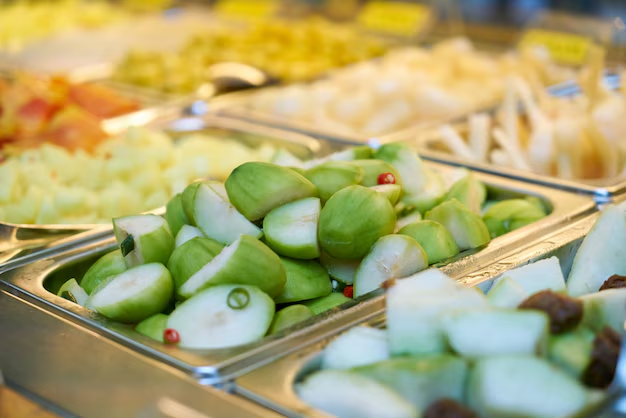How Long Can You Keep Ceviche in the Refrigerator? Discover the Secrets to Safe and Delicious Storage!
Imagine this: you're enjoying a vibrant plate of ceviche, its citrusy aroma is an enticing mix of tang and zest. Whether it's from a seaside retreat or your kitchen, this dish—known for its fresh, uncooked fish cured in citrus juices—promises a delightful culinary experience. But what happens when you have leftovers? How long does ceviche last in the refrigerator without compromising safety or flavor? Let us embark on a comprehensive exploration of ceviche storage, ensuring your leftovers remain as vibrant and delightful as the first bite.
🤔 Understanding Ceviche: A Quick Primer
Before diving into storage specifics, it’s essential to understand what ceviche is. Traditionally, it's a Latin American dish made from raw seafood, usually fish or shrimp, cured and marinated in fresh citrus juices, typically lime or lemon. Various regions incorporate ingredients such as onions, cilantro, and chili peppers for added flavor. The acumen behind ceviche is the chemical process where acids of citrus juices "cook" the fish proteins. However, this curing method isn't as foolproof as heat cooking, especially concerning shelf life and safety.
🍤 The Ceviche Composition: Ingredients Matter
- Fish or Seafood: The fresher, the better. Factors like sourcing and freshness significantly impact the storage period.
- Citrus Juice: Essential for curing, also acts as a pH protector against bacterial growth.
- Add-ins: Ingredients such as onions, peppers, or herbs contribute to spoilage rates.
🕒 The Shelf Life of Ceviche in the Fridge
Generally, ceviche lasts about one to two days in the refrigerator. This timeframe can vary based on ingredient freshness and preparation conditions. Proper storage is crucial to extend its lifespan safely.
Key Factors Affecting Ceviche's Shelf Life
- Freshness of Ingredients: Always begin with fresh seafood; ideally, consume ceviche the same day. Day-old seafood might not hold up to even brief storage.
- Refrigeration Practices: Store ceviche in an airtight container before refrigerating to prevent exposure to air and minimize spoilage risks.
- Citrus Content: A higher citrus content can slightly prolong ceviche's safety window due to its preservative qualities.
⏰ How to Store Ceviche for Optimal Freshness
- Place ceviche in a tightly sealed container to maintain its quality.
- Store it in the coldest part of the refrigerator, generally the back or bottom shelf, where temperature fluctuations are minimal.
- Avoid re-refrigerating ceviche once served or left out, as repeated temperature changes can hasten spoilage.
🚨 Signs Your Ceviche May Have Gone Bad
Recognizing when ceviche is no longer safe to consume is crucial. If you're unsure about the freshness of your ceviche, look for these spoilage signals:
- Off Odors: An unusual or strong fishy smell indicates spoilage.
- Texture Changes: Slimy or overly mushy texture suggests it's past its prime.
- Discoloration: Dull or grayish hue in seafood can denote spoilage.
- Tastes Sour or Bitter: Overly sour taste could mean the citrus has deteriorated.
🥗 Related Topics: Enhancing Your Ceviche Experience
Innovating with Ingredients
Dare to experiment with different types of seafood and flavor twists. How about trying scallops with a hint of tropical fruit like mango or kiwi? Each ingredient introduces different texture and taste notes that could inspire fresh culinary adventures.
🥣 Alternative Ways to Enjoy Leftover Ceviche
Once you've ensured your ceviche is still good to eat, there are creative ways to enjoy it:
- Taco Filling: Use it as a vibrant stuffing for soft tacos.
- Salad Topper: Add a fresh zest to salads with leftover ceviche.
- Ceviche Toast: Smear your favorite bread with avocado spread, top with ceviche for an exciting twist on brunch.
🛡️ Emphasizing Food Safety Precautions
Safety in seafood handling can't be overstated, and ceviche calls for particular prudence alongside culinary flair.
🧼 Best Practices for Handling and Preparing Ceviche
- Seafood Sourcing: Only purchase seafood from reputable suppliers or stores.
- Proper Hygiene: Wash hands, surfaces, and utensils thoroughly before and after preparation.
- Cooling Efficiently: Prep in small batches to ensure all components remain cold during assembly.
🌟 Handy Summary: Ceviche Storage Tips & Tricks
Below is a visually distinct summary of ceviche storage insights:
Quick Ceviche Storage Reminder 📝
- Use Fresh Ingredients: Always start with the freshest seafood.
- Consume Within 1-2 Days: Limit refrigeration to two days for peak safety.
- Seal Properly: Store in airtight containers.
- Check for Spoilage: Use your senses—smell, taste, look.
Remember, while ceviche is a delightful dish, it involves raw seafood, making immediate consumption the surest way to enjoy it safely.
Final Note: Savoring Safely
Embracing ceviche's allure is as much about flavor as it is about understanding its delicate nature. By adhering to robust storage practices and remaining attentive to signs of spoilage, you can continue to enjoy this vibrant dish while prioritizing safety. Turn every ceviche experience into an opportunity to explore, experiment, and savor!
